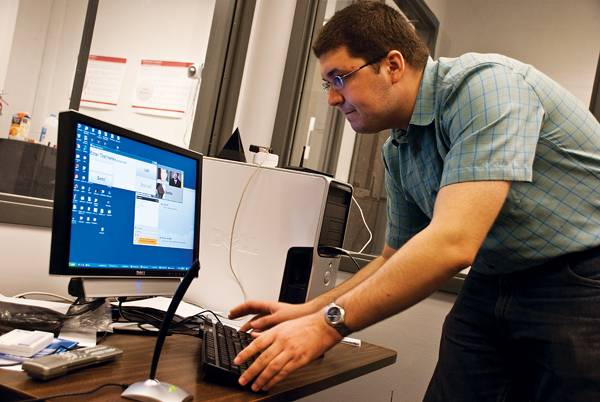Smart home works towards aid for aging

Igors Svecs, senior in computer science, demonstrates some of the software during a tour of the Smart House Lab, Tuesday, at Atanasoff Hall. Photo: Karuna Ang/Iowa State Daily
September 1, 2009
Though the idea of living in a world filled with robots, elaborate machines and automated kitchen appliances may seem out of reach, a research project at Iowa State has realized a world living with whimsical and useful inventions of the future.
Johnny Wong, professor and associate chair in computer science, and Carl Chang, professor and associate chair in computer science, are leading the smart home project at Iowa State.
A “smart home” is a house equipped with multiple sensors to monitor daily life. Wong said the main goal of the project was the development of gerontechnology, or technology to help the elderly. Around the lab, located in the basement of Atanasoff Hall, they call it Gero-Technology.
“He [Wong] likes the name better without the “N.” We all think it sounds cooler,” Chang said.
They have been working on the project for four years and have attended several international conferences dedicated to smart home research. The team is “playing a significant role” in the developments of this area, Chang said.
He said in addition to main goal of developing technology to help the elderly, the project offers opportunities to gain research experience.
“A large majority of the work [at the lab] is actually done by students,” Wong said.
Chang said working in the smart home lab is different from most research opportunities available to computer science students because students are not dealing with systems, but with human beings.
“It’s good for students because it matures their research and gets them away from complex equations,” Chang said.
Igors Svecs, senior in computer science, gave a tour of the lab and displayed the progress of several demos the team is developing for the smart home. Everything in the house was either voice activated or accessed through a computer using a special easy-to-use interface. There were three large buttons on the interface screen labeled “chat,” “call,” and “food.” An internet browser popped up on the screen linked to a page where a user could call local restaurants when the “food” option was clicked. By clicking on “call” there brought up a series of photos on screen. Clicking on one of these pictures then linked the interface to Skype, which would begin to call the number assigned to that photo. Clicking on “chat” activated the voice recognition software. When Svecs said, “Listen to ‘Another Day in Paradise,’” the computer began playing the song over the house speakers. He also demonstrated several other voice commands such as “time” and “date” to which a voice responded with the correct answers over the speaker system. Svecs said that developing different methods to interface with the house was incredibly important.
“People with different needs need different interfaces,” he said.
Everyday kitchen appliances were upgraded and outfitted with sensors and new features in the smart home. The microwave is able to automatically calculate cooking times and the nutritional facts of food items by scanning bar codes. The refrigerator can calculate the weights of food items inside and announce when items are running low. The main computer system connected to all of these appliances then sends a shopping list to the resident’s cell phone, taking in consideration the average consumption of food, representing all food groups and what items are running low at the house.
To help develop technologies in the area of healthy living, Wong and Chang are working closely with Hen-I Yang, a computer science post-doctorate trainee, who was working with a similar project in Florida.
He said future developments in this area will be geared towards creating an in-house health care system. The computer would cross reference any medication the resident is taking with the food inside the refrigerator and cabinets. Using that information, the house would let the resident know if anything they are eating would be dangerous while taking the prescribed medicine. Yang also said they are developing an improved dietary system and sensors to aid with exercise and personal health.
Currently, the team has received Institutional Review Board approval for future testing but is waiting for grant money to fund additional research.
In terms of future plans, Chang and Wong said they were excited about the possibility of an extension program, which would include a complex on campus outfitted with this technology.
To do this, they would work with Volunteers of America, who would build 20 units of low-income housing on campus property. The university would then lease the land to the smart home research team for next to no cost, who could then outfit the units with smart home technology. Chang said this would be a huge opportunity for the university because Iowa is one of the only states where low-income housing hasn’t been built yet.
If the plan for this complex becomes a reality, Iowa State would be the location of the only low-income housing complex in Iowa. Wong said that the smart home team would build and manage the units and, in return, Iowa State would be able to use the units for research. These units would also give students from other majors, such as human sciences, access to these homes. Using the complex, students could create studies of their own based on the technology.
Wong summed up the project’s goals by saying they hope to make an impact for people with special needs while benefitting the university and its students.
“There is a lot of possibility in this area for students to get experience,” Wong said.






